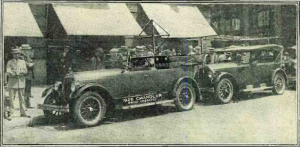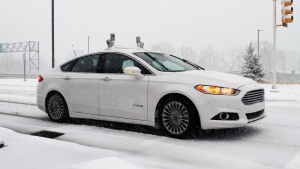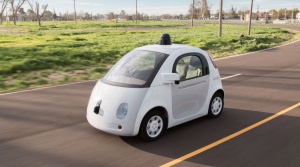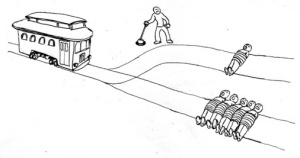Autonomous Vehicles
Autonomous cars (self-driving cars, robot cars, automated cars) are cars that have the ability to sense their surroundings and subsequently use data to make decisions. Autonomous cars have come a long way in the last twenty years, from creating simpler park assist technologies, to equipping vehicles with technology that allows them to monitor surroundings, change lanes, and make emergency stops. Self driving cars have been featured at Expos, Worlds Fairs, and more recently have made appearances at the North American International Auto Show and the Consumer Electronics Show. Overall these cars are safer than traditional driving because they can sense obstacles and react to them quicker than humans.[1] There are however, some ethical considerations that pertain to the increased safety measures that these cars may provide. Because autonomous vehicles are designed by humans, there is debate over who should determine the vehicles' tendencies.
Contents
History
Beginnings
Autonomous cars have origins in the 1920s when then Houdini Radio Control Company installed radio control equipment in a 1926 Chandler.[2] From 1950 to 1980 numerous companies and universities attempted to control cars by laying guide wires in the roadway.[3] These electronically controlled cars made appearances at numerous world showcases. During the 1990s, we began to see the transition towards autonomous vehicles of today.
Today
Modern self-driving cars do much more than follow wires placed in the road way. New designs attempt to enable cars to make decisions about routes, safety, and changing lanes. Collectively, these enhancements are referred to as "driver assists" which designates them as distinct from driver replacements and true autonomy. This technology is far more sophisticated than that of previous models, which were controlled by humans on the other end of a remote control.
Autonomous driving systems were deployed by large corporations like Uber and Tesla, Inc. as early as the summer of 2016 [4] and are currently beginning to be adopted. Such systems already require little to no human input while driving on public roadways under certain conditions. These modern vehicles use a combination of radar, GPS, odometers, computer programs, and machine learning to safely navigate roadways.
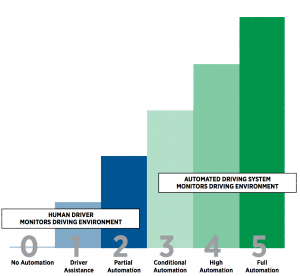
Future
Levels of Autonomy
Any autonomous driving system is classified by common convention into one of six levels ranging from Level 0 to Level 5, depending on the degree of sophistication of the system. The measure of that sophistication, and thus the metric which determined the appropriate level, is the amount of input and attention required of a human operator in order to safely direct the vehicle.[5]
Level 0
No Automation: The human driver is in charge of all aspects of driving but the vehicle may have warning or minor intervention systems.[5]
Level 1
Driver Assistance: The driver assistance system is in charge of either steering or accelerating and decelerating using driving environment information but the human driver is in charge of all remaining driving tasks.[5]
Level 2
Partial Automation: One or more assistance systems for both steering and accelerating and decelerating using driving environment information but the human driver is in charge of all remaining driving tasks.[5]
Level 3
Conditional Automation: The automated driving system performs all aspects of driving but with a human driver responding to requests to intervene to override the system.[5]
Level 4
High Automation: The automated driving system performs all aspects of driving even in the case where a human driver does not properly respond to a request to intervene and override the system.[5]
Level 5
Full Automation: Complete performance of the automated driving system of all aspects of driving under all road and environment conditions that could be handled by a human driver.[5]
Public Opinion
In a 2011 survey by Accenture, 49% of US and UK consumers stated that they would be comfortable using a "driverless car".[6]
In a 2012 survey by JD Power and Associates, 37% of respondents said they would be interested in purchasing a fully autonomous car. However, that number dropped to 20% when told that the technology would cost more than $3,000.[7]
In a 2014 survey by Insurance.com, over 75% of licensed drivers said they would at least consider buying a self-driving car. This number rose to 86% if their car insurance would be cheaper for an autonomous vehicle. 31.7% said they would not continue to drive anymore if autonomous cars became available.[8]
In a 2015 survey by Delft University of Technology, respondents, on average, found manual driving the most enjoyable mode of driving. 22% of the survey respondents did not want to spend any money for a fully automated driving system, whereas 5% indicated they would be willing to pay more than $30,000. 33% of respondents indicated that fully automated driving would be highly enjoyable. 69% of respondents estimated that fully automated driving will reach a 50% market share between now and the year 2050.[9]
Legislation
With rapid developments still happening in the field of autonomous cars, it is hard for regulatory agencies to make laws about their design and usage. Today, 12 states have enacted legislature pertaining to autonomous vehicles[10]. Most laws in regards to autonomous vehicles are similar to legislation that has been passed in the state of Michigan. Michigan Senate Bill 0169, which was passed in 2013, defines automation:
“Automated technology” means technology installed on a motor vehicle that has the capability to assist, make decisions for, or replace an operator.
Definines what an operator of an autonomous vehicle is:
Sec. 35a. “Operate” or “operating” means 1 or more of the following:
(a) Being in actual physical control of a vehicle. This subdivision applies regardless of whether or not the person is
licensed under this act as an operator or chauffeur.
(b) Causing an automated motor vehicle to move under its own power in automatic mode upon a highway or street
regardless of whether the person is physically present in that automated motor vehicle at that time. This subdivision
applies regardless of whether the person is licensed under this act as an operator or chauffeur. As used in this subdivision,
“causing an automated motor vehicle to move under its own power in automatic mode” includes engaging the automated
technology of that automated motor vehicle for that purpose.
And explains the registration and insurance protocol for such a vehicle[11]. Michigan Senate Bill 0663, also passed in 2013 explains that a manufacturer is free of liability if a third party makes any altercations to a vehicle [12]. Other laws like Tennessee Senate Bill 307 make it illegal for local municipalities to ban the use of autonomous vehicles [13].
Current Models
Many of the worlds leading automakers along with technologies companies are developing autonomous vehicles or autonomous technology for vehicles. Most estimate that, at the very least, they will be producing a partially autonomous vehicle by 2020. Some companies developing autonomous vehicles include Audi, BMW, Ford, General Motors, Google, Mercedes Benz, Nissan, Tesla, Toyota, Uber, Volkswagen, and Volvo.
Ford
Ford calls themselves one of the pioneers in autonomous vehicle technology and has recently began testing their vehicles at the University of Michigan’s Mcity and conducting real world snow tests [14][15]. Ford has two generations of autonomous vehicles. In 2003 Ford installed LiDAR technology on an F-250 Super Duty for participation in the DARPA challenge. The second generation of testing began in 2011 with the Ford Fusion sedan because of its advanced electrical systems. In January of 2016 Ford announced that it would expand its fleet of autonomous Fusions to 30 vehicles [16].
Google’s self-driving car project, based out of Mountain View, California, began in 2009 and hit the road for testing in 2012 [17]. Currently Google operates two types of autonomous vehicles. The first group is composed of Toyota Priuses and Lexus RX450hs. These vehicles are used by engineers to test driving systems in real world traffic. Google has begun testing a concept car developed in collaboration with Bosch, ZF Lenksysteme, LG, Continental, and Roush [18]. These vehicles are designed without peddles or steering wheels. As part of their concept car experiment Google has asked citizens to submit artwork for their Paint the Town initiative. Artwork has been featured on cars in Mountain View, California, and Austin, Texas. Google expects to have vehicles available for purchase in 2020. The cars still need to undergo testing in both snow and heavy rain [19].
Safety Concerns
As company like Google have been able to make their autonomousis cars street legal, a variety of safety concerns have arisen over the presence of self-driving vehicles sharing the road with traditional human driven vehicles. Since 2009, Google's self-driving cars have been involved in a total of sixteen crashes, which have mostly consisted of fender benders. All sixteen crashes were faulted as human error, however, in a 2015 report, the New York Times wrote that the car's tendency to "drive by the book" lead to over maneuvering to prevent collisions, often confusing other human drivers on the road and resulting in the subsequent accidents. [20]
In 2015, the Telsa Motors company enabled an autopilot feature through a software update to existing cars. While CEO Elon Musk claimed that the feature would result in radical improvements for vehicle safety, the company failed to prevent drivers from abusing the feature. While in autopilot mode, the company recommends that drivers keep both hands on the car steering wheel. [21] However, additional constraints had to be enforced after a slew of YouTube videos emerged of drivers using the autopilot feature without their hands on the steering wheel. [22] Currently, regulators have banned Telsa from activating the feature in Hong Kong, and other countries may soon follow suit.
Ethical Concerns
Computer ethicists and informed citizens alike are closely following the development of autonomous cars. With transition from automated to autonomous there are an increased number of decisions that must be made by designers[23].
Responsibility
Much of the legislation relating to autonomous vehicles has related to responsibility. The question is whether consequences from autonomous cars should fall on manufacturers, owners, or others. This debate is furthered when cars are considered autonomous agents and have the ability to learn and change themselves. Product liability laws are one venue of research on this dilemma that places responsibility for defects, injuries, and other unforeseen negative effects of sold products on any entities involved in the manufacture or selling processes. Being as autonomous cars are a tangible product, these laws may provide a framework for how responsibility can be regulated. [24]
Bryant Walker Smith, an assistant law professor at the University of South Carolina, was quoted in April of 2017 saying that the level of automation today is at two or below and that drivers are responsible for crashes in these cases.[25] He went on to say that liability for crashes will move from driver to vehicle as the level of automation rises.
Trolley Problem
The trolley problem, or trolley dilemma, is a thought experiment used be ethicists and designers across many different disciplines. While there are a number of variations on the story goes: there is a runaway trolley headed down a track tow which five people are tied. You however are standing next to a switch which you could throw and reroute the trolley on to a track with only one person tied to it. You can do two things, do nothing and let the trolley kill 5 people, or throw the switch which would result in only one person being killed. This same decision will have to be made by the designers of autonomous vehicles. While we might be faced with same problem while driving an ordinary car down the road it is generally recognized that there is a difference. While driving down the road in a normal car this would be a split section decision made by the driver. With autonomous cars the decisions is far from split second. This leads to the question of who will be making the decision of which path our cars would take. Recently Google’s Chris Urmson has down played the trolley problem as in pertains to self-driving cars [26].
See Also
References
- ↑ Saftey of driverless cars http://www.cnbc.com/2014/09/08/self-driving-cars-safer-than-those-driven-by-humans-bob-lutz.html
- ↑ Milwaukee Sentinel Houdini Article https://news.google.com/newspapers?id=unBQAAAAIBAJ&sjid=QQ8EAAAAIBAJ&pg=7304,3766749&hl=en
- ↑ Press Courier reporter rides in "wired" carhttps://news.google.com/newspapers?id=vUpeAAAAIBAJ&sjid=3WANAAAAIBAJ&pg=6885,3667738&hl=en
- ↑ Chafkin, Max. "Uber's First Self-Driving Fleet Arrives in Pittsburgh This Month." Bloomberg.com. Bloomberg, 18 Aug. 2016. Web. https://www.bloomberg.com/news/features/2016-08-18/uber-s-first-self-driving-fleet-arrives-in-pittsburgh-this-month-is06r7on
- ↑ 5.0 5.1 5.2 5.3 5.4 5.5 5.6 5.7 SAE Report on Automated Driving. Rep. no. J3016. SAE International, n.d. Web. https://www.sae.org/misc/pdfs/automated_driving.pdf
- ↑ newsroom.accenture.com/article_display.cfm?article_id=5146
- ↑ http://www.cnet.com/roadshow/news/many-car-buyers-show-interest-in-autonomous-car-tech/
- ↑ http://www.insurance.com/about-us/news-and-events/2014/07/autonomous-cars-bring-em-on-drivers-say-in-insurance.com-survey.html?utm_source=feedburner&utm_medium=feed&utm_campaign=Feed%3A+insurance_info+(Insurance.com+RSS+Article+Feed)
- ↑ http://www.sciencedirect.com/science/article/pii/S1369847815000777
- ↑ Listing of Autonomous Vehicle legislation from National Conference of State Legislature http://www.ncsl.org/research/transportation/autonomous-vehicles-legislation.aspx
- ↑ Michigan Senate Bill 169 http://www.legislature.mi.gov/documents/2013-2014/publicact/pdf/2013-PA-0231.pdf
- ↑ Michigan Senate Bill 663 http://www.legislature.mi.gov/documents/2013-2014/publicact/pdf/2013-PA-0251.pdf
- ↑ Tennessee Senate Bill 598 http://www.tn.gov/sos/acts/109/pub/pc0307.pdf
- ↑ Ford.com news story featuring MCity https://media.ford.com/content/fordmedia/fna/us/en/news/2015/11/13/ford-first-automaker-to-test-autonomous-vehicle-at-mcity.html
- ↑ Ford.com news article highlighting snow testinghttps://media.ford.com/content/fordmedia/fna/us/en/news/2016/01/11/ford-conducts-industry-first-snow-tests-of-autonomous-vehicles.html
- ↑ Ford.com news story featuring the expansion of their autonomous fleet https://media.ford.com/content/fordmedia/fna/us/en/news/2016/01/05/ford-tripling-autonomous-vehicle-development-fleet--accelerating.html
- ↑ Google Car Homepage https://www.google.com/selfdrivingcar/
- ↑ Google Concept Car Partners http://www.autonews.com/article/20150114/OEM09/150119815/google-in-talks-with-oems-suppliers-to-build-self-driving-cars
- ↑ Google Cars in Snow http://www.bloomberg.com/news/articles/2015-01-14/google-sees-fielding-selfdriving-car-within-5-years
- ↑ http://www.nytimes.com/2015/09/02/technology/personaltech/google-says-its-not-the-driverless-cars-fault-its-other-drivers.html?_r=0
- ↑ http://www.theverge.com/2015/11/20/9770902/tesla-model-s-autopilot-disabled-hong-kong-regulations
- ↑ http://www.theverge.com/2015/10/21/9589724/tesla-autopilot-videos-youtube-safety-advice-ignored
- ↑ http://ed.ted.com/lessons/the-ethical-dilemma-of-self-driving-cars-patrick-lin
- ↑ http://www.brookings.edu/research/papers/2014/04/products-liability-driverless-cars-villasenor#ftn26
- ↑ "Who is liable if a self-driving car crashes? Tesla mishap raises issues" https://www.usatoday.com/story/money/cars/2017/04/03/tesla-mishap-raises-issues-self-driving-liability/99880620/
- ↑ https://www.washingtonpost.com/news/innovations/wp/2015/12/01/googles-leader-on-self-driving-cars-downplays-the-trolley-problem/
